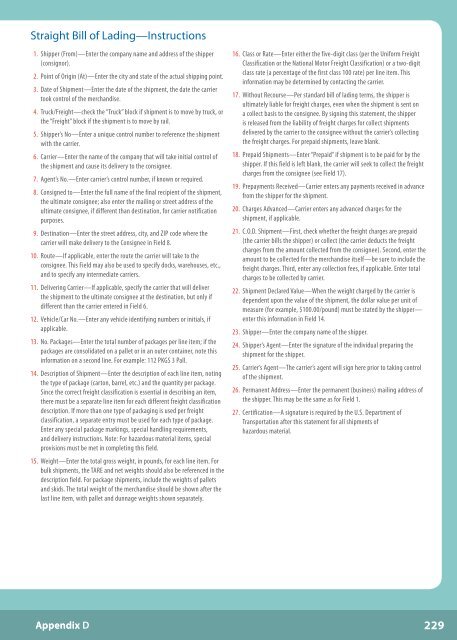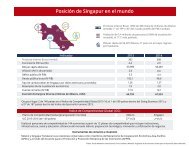basic-guide-to-exporting_Latest_eg_main_086196
basic-guide-to-exporting_Latest_eg_main_086196
basic-guide-to-exporting_Latest_eg_main_086196
Create successful ePaper yourself
Turn your PDF publications into a flip-book with our unique Google optimized e-Paper software.
Straight Bill of Lading—Instructions1. Shipper (From)—Enter the company name and address of the shipper(consignor).2. Point of Origin (At)—Enter the city and state of the actual shipping point.3. Date of Shipment—Enter the date of the shipment, the date the carrier<strong>to</strong>ok control of the merchandise.4. Truck/Freight—check the “Truck” block if shipment is <strong>to</strong> move by truck, orthe “Freight” block if the shipment is <strong>to</strong> move by rail.5. Shipper’s No—Enter a unique control number <strong>to</strong> reference the shipmentwith the carrier.6. Carrier—Enter the name of the company that will take initial control ofthe shipment and cause its delivery <strong>to</strong> the consignee.7. Agent’s No.—Enter carrier’s control number, if known or required.8. Consigned <strong>to</strong>—Enter the full name of the final recipient of the shipment,the ultimate consignee; also enter the mailing or street address of theultimate consignee, if different than destination, for carrier notificationpurposes.9. Destination—Enter the street address, city, and ZIP code where thecarrier will make delivery <strong>to</strong> the Consignee in Field 8.10. Route—If applicable, enter the route the carrier will take <strong>to</strong> theconsignee. This Field may also be used <strong>to</strong> specify docks, warehouses, etc.,and <strong>to</strong> specify any intermediate carriers.11. Delivering Carrier—If applicable, specify the carrier that will deliverthe shipment <strong>to</strong> the ultimate consignee at the destination, but only ifdifferent than the carrier entered in Field 6.12. Vehicle/Car No.—Enter any vehicle identifying numbers or initials, ifapplicable.13. No. Packages—Enter the <strong>to</strong>tal number of packages per line item; if thepackages are consolidated on a pallet or in an outer container, note thisinformation on a second line. For example: 112 PKGS 3 Pall.14. Description of Shipment—Enter the description of each line item, notingthe type of package (car<strong>to</strong>n, barrel, etc.) and the quantity per package.Since the correct freight classification is essential in describing an item,there must be a separate line item for each different freight classificationdescription. If more than one type of packaging is used per freightclassification, a separate entry must be used for each type of package.Enter any special package markings, special handling requirements,and delivery instructions. Note: For hazardous material items, specialprovisions must be met in completing this field.15. Weight—Enter the <strong>to</strong>tal gross weight, in pounds, for each line item. Forbulk shipments, the TARE and net weights should also be referenced in thedescription field. For package shipments, include the weights of palletsand skids. The <strong>to</strong>tal weight of the merchandise should be shown after thelast line item, with pallet and dunnage weights shown separately.16. Class or Rate—Enter either the five-digit class (per the Uniform FreightClassification or the National Mo<strong>to</strong>r Freight Classification) or a two-digitclass rate (a percentage of the first class 100 rate) per line item. Thisinformation may be determined by contacting the carrier.17. Without Recourse—Per standard bill of lading terms, the shipper isultimately liable for freight charges, even when the shipment is sent ona collect basis <strong>to</strong> the consignee. By signing this statement, the shipperis released from the liability of freight charges for collect shipmentsdelivered by the carrier <strong>to</strong> the consignee without the carrier’s collectingthe freight charges. For prepaid shipments, leave blank.18. Prepaid Shipments—Enter “Prepaid” if shipment is <strong>to</strong> be paid for by theshipper. If this field is left blank, the carrier will seek <strong>to</strong> collect the freightcharges from the consignee (see Field 17).19. Prepayments Received—Carrier enters any payments received in advancefrom the shipper for the shipment.20. Charges Advanced—Carrier enters any advanced charges for theshipment, if applicable.21. C.O.D. Shipment—First, check whether the freight charges are prepaid(the carrier bills the shipper) or collect (the carrier deducts the freightcharges from the amount collected from the consignee). Second, enter theamount <strong>to</strong> be collected for the merchandise itself—be sure <strong>to</strong> include thefreight charges. Third, enter any collection fees, if applicable. Enter <strong>to</strong>talcharges <strong>to</strong> be collected by carrier.22. Shipment Declared Value—When the weight charged by the carrier isdependent upon the value of the shipment, the dollar value per unit ofmeasure (for example, $100.00/pound) must be stated by the shipper—enter this information in Field 14.23. Shipper—Enter the company name of the shipper.24. Shipper’s Agent—Enter the signature of the individual preparing theshipment for the shipper.25. Carrier’s Agent—The carrier’s agent will sign here prior <strong>to</strong> taking controlof the shipment.26. Permanent Address—Enter the permanent (business) mailing address ofthe shipper. This may be the same as for Field 1.27. Certification—A signature is required by the U.S. Department ofTransportation after this statement for all shipments ofhazardous material.Appendix D229





